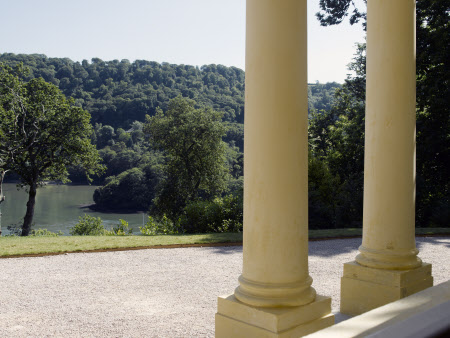
This is a lovely part of Britain. Its climate is famed, as are its palms. It displays many of the characteristics of the “other” Riviera, an ideal place to paint and even write. But, on the face of it, one wouldn’t expect those jottings to be about murder, and one would be still more shocked to realise that the setting for many of the dastardly deeds penned by Agatha Christie, was actually this sparkling idyll.
Agatha Christie is the most celebrated daughter of Torquay on the South Devon coast. She was born in 1890 and named Agatha Mary Clarissa Miller. She married Archibald Christie on Christmas Eve 1914. The Grand Hotel on Torquay’s seafront was the honeymoon hotel, and today it marks the start of the Agatha Christie Mile, which takes in many of the places significant to the author. Close to the Tourist Centre is a sculpture of Agatha Christie. The bronze bust was unveiled on September 15th, 1990 by her daughter, Mrs Rosalind Hicks, to commemorate the centenary of the author’s birth.
The First World War found Agatha working as a nurse at Torquay Town Hall, which had been converted into a Red Cross hospital. It’s there that she gained her knowledge of poisons, and that was to come in handy a little later.
 Agatha Christie’s first novel ‘The Mysterious Affair at Styles’ was published in 1920 and introduced the popular detective Hercule Poirot. No fewer than fifteen of Agatha Christie’s crime novels are set in Devon, or have connections with the county.
Agatha Christie’s first novel ‘The Mysterious Affair at Styles’ was published in 1920 and introduced the popular detective Hercule Poirot. No fewer than fifteen of Agatha Christie’s crime novels are set in Devon, or have connections with the county.
The famous caves at Kents Cavern in Torquay were Agatha Christie’s inspiration for Hempsley Cavern in ‘The Man in the Brown Suit’ (1924). These caves are unique and atmospheric, and artefacts from the Roman era have been found inside. They are open during the day, but their scary night-time tours are popular with locals and tourists who are looking for a bit of a thrill!
Anyone interested in the life of one of Britain’s best loved authors will want to visit Greenway. In 1938, Agatha bought the Greenway Estate near Brixham with her second husband, Max Mallowan. (Greenway becomes Nasse House in ‘Dead Man’s Folly’.) Agatha Christie always knew about the magnificent house perched on the high banks above the picturesque River Dart. It was to become her holiday home where she would play her piano and perhaps just take a few notes for future books. Greenway became the home of her daughter Rosalind and son-in-law, Anthony Hicks. One can listen to a recording of Agatha’s voice and imagine the Grande Dame of crime dressed in something floaty and thirties, sipping a gin and tonic, entertaining posh guests who would be smoking cheroots.
The library is one of the most striking rooms. It’s not large but is noteworthy for the hand-painted frieze that runs around the top of the wall. It was painted in 1943 by Lt Marshall Lee, when the house was occupied by the US Coastguard. It depicts many of the important events of their personal war. It starts by showing their base in Key West, Florida, and it ends with an image of the house with an Infantry Landing Craft in the river below.
 Agatha Christie frequently visited Lord and Lady Churston at their manor house in Churston village. With the proceeds of one of her books she donated a stained glass window to Churston Church. Hercule Poirot and Captain Hastings travelled by steam railway in ‘The ABC Murders’ (1936), where Churston station is mentioned. Agatha renames the station ‘Nassecombe’ in ‘Dead Man’s Folly’ (1956).
Agatha Christie frequently visited Lord and Lady Churston at their manor house in Churston village. With the proceeds of one of her books she donated a stained glass window to Churston Church. Hercule Poirot and Captain Hastings travelled by steam railway in ‘The ABC Murders’ (1936), where Churston station is mentioned. Agatha renames the station ‘Nassecombe’ in ‘Dead Man’s Folly’ (1956).
One can reach Greenway House via a steep track from Greenway Quay. Poirot discovers a large bell and a notice ‘Ring for the Ferry’. That bell is also mentioned in ‘Ordeal by Innocence’ (1958). Across the river lies the village of Dittisham (re-named Gitcham in ‘Dead Man’s Folly’), which can be reached by the passenger ferry.
Agatha Christie might seem a bit Old School but her books are still being read and appreciated across the globe. They have been translated into more than 100 languages. Her novels have sold roughly four billion copies, and her estate claims that her works rank third, after those of William Shakespeare and the Bible, as the most widely published books.
A rare edition of an Agatha Christie novel, which originally cost 37p, has sold for more than £40,000 at auction. The 1924 edition of ‘Poirot Investigates’, with a dust jacket showing the detective, went for a world record price, beating the previous largest sum paid for an Agatha Christie book of £10,000.
This area has so much to offer any lover of the novels of Agatha Christie but a visit here will be far from a dry and dusty literary tour. There are gardens, beaches, caves, and tranquillity. That steam railway will transport you back to a gentler time. The English Riviera has changed over the past century but it’s still easy to see why that author chose to stay.

Paignton and Dartmouth Steam Railway
Dart Valley Railway, Queen’s Park Station, Torbay Road, Paignton TQ4 6AF
01803 555872
www.paignton-steamrailway.co.uk
Kents Cavern
Cavern House, 89/91 Ilsham Road, Torquay TQ1 2JF
01803 215136
www.kents-cavern.co.uk
Email: caves@kents-cavern.co.uk
Torquay Tourist Information Centre
Vaughan Parade, Torquay TQ2 5JG
01803 297428
www.TheEnglishRiviera.co.uk
Email: torquay.tic@torbay.gov.uk
Travel review by Chrissie Walker © 2018
